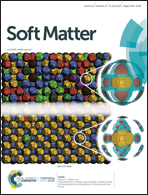pH-Switchable IFT variations and emulsions based on the dynamic noncovalent surfactant/salt assembly at the water/oil interface†
Abstract
Additional HCl can facilely control the dynamic noncovalent interaction between anionic surfactant sodium dodecyl benzene sulfonate (SDBS) and additional organic matter, 4,4′-oxydianiline (ODA), at the water/oil interface. At low HCl concentration (ODA/HCl molar ratio (r) = 1 : 1.5, [ODA] = 250 mg L−1), the ODA+ ions effectively enhanced the SDBS ability to reduce the water/oil interfacial tension (IFT) by about two orders of magnitude, while the (SDBS)2/ODA2+ gemini-like surfactants could be constructed at a relatively high HCl concentration (r = 1 : 4, [ODA] = 250 mg L−1), which could largely reduce the IFT to 1.19 × 10−3 mN m−1. Molecular simulation was employed to explore the interfacial activity of ODAn+ (ODA+/ODA2+) ions and the SDBS/ODAn+ interaction. The control experiments used another three surfactants to verify the proposed model. The pH-switchable gradual protonation of amino groups in ODA molecules determined the SDBS/ODA interfacial assembly, which was responsible for the reversal of IFT variations and the related emulsion behaviors.



 Please wait while we load your content...
Please wait while we load your content...